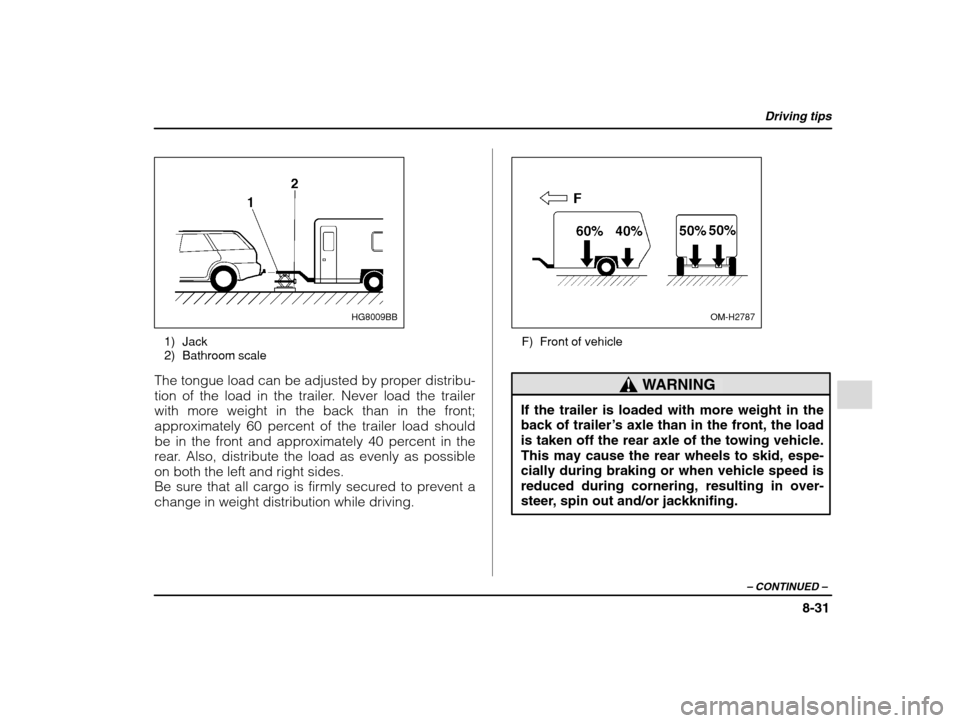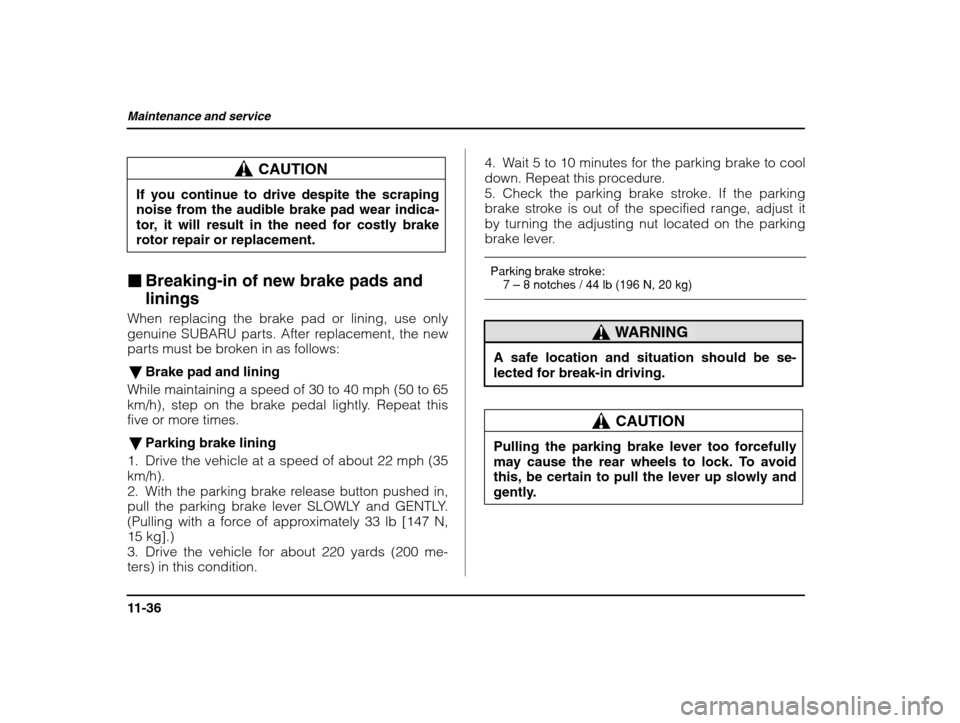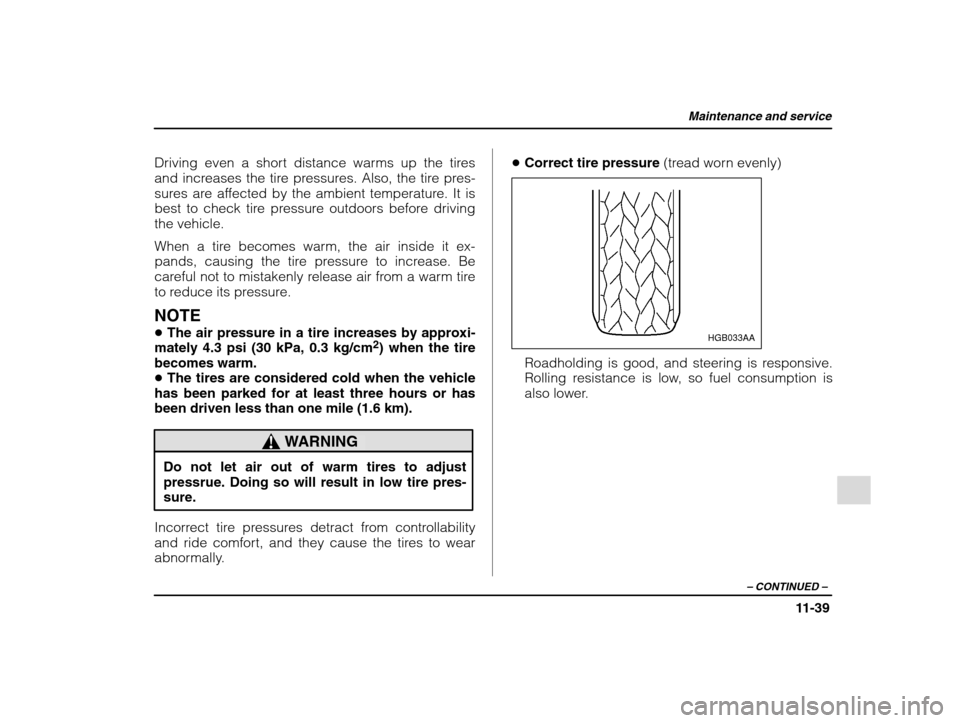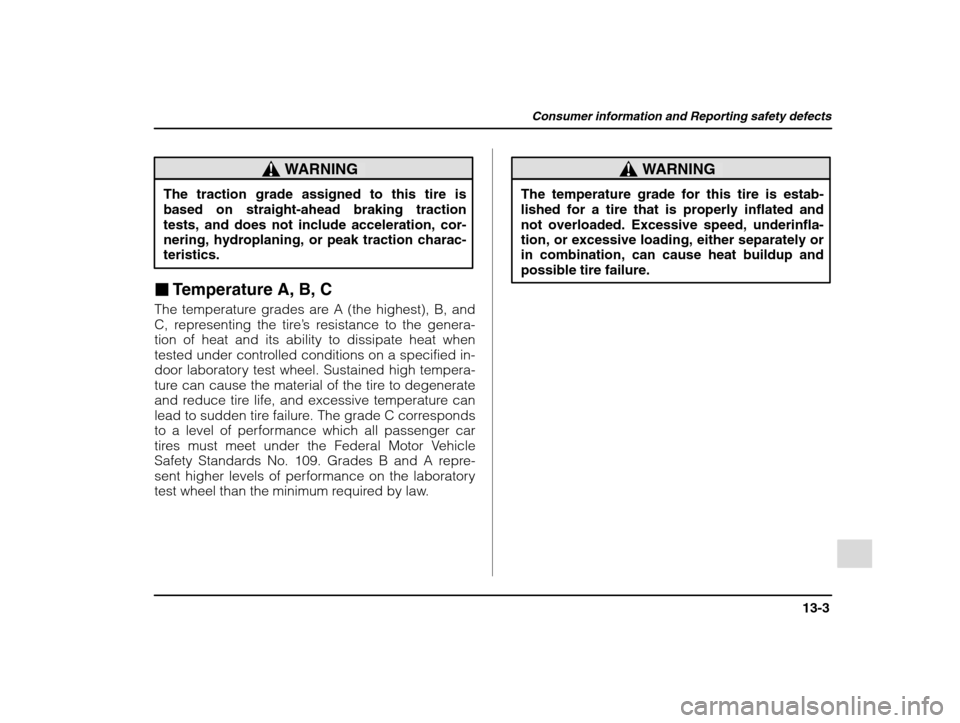2002 SUBARU IMPREZA WRX ESP
[x] Cancel search: ESPPage 258 of 390

Driving tips
8-27
– CONTINUED –
Trailer towing
Your car is designed and intended to be used pri-
marily as a passenger-carrying vehicle. Towing a
trailer puts additional loads on your car ’s engine, dri-
vetrain, brakes, tires and suspension and has an
adverse effect on fuel economy.
If you do decide to tow a trailer, your safety and sat-
isfaction depend upon proper use of correct equip-
ment and cautious operation of your vehicle. Seekthe advice of your SUBARU dealer to assist you in
purchasing a hitch and other necessary towing
equipment appropriate for your vehicle. In addition,
be sure to follow the instructions on correct installa-
tion and use provided by the trailer and other towing
equipment manufacturers.
SUBARU assumes no responsibility for injuries or
vehicle damage that result from trailer towing equip-
ment, or from any errors or omissions in the instruc- tions accompanying such equipment or for your fail-
ure to follow the proper instructions. � Warranties and maintenance
SUBARU warranties do not apply to vehicle damage or malfunction caused by trailer towing. If you use
your vehicle to tow a trailer, more frequent mainte-
nance will be required due to the additional load. (Refer to
“Maintenance schedule under severe driv-
ing conditions ” in the “Warranty and Maintenance
Booklet”.)
Under no circumstances should a trailer be towedwith a new vehicle or a vehicle with any new power-
train component (engine, transmission, differential, wheel bearings, etc.) for the first 1,000 miles (1,600 km) of driving. � Maximum load limits
WARNING
Never exceed the maximum load limits ex-
plained below. Exceeding the maximum loadlimits could cause personal injury and/or ve-hicle damage.
CAUTION
�Adequate size trailer brakes are required
when the trailer and its cargo exceed 1,000 lbs (453 kg) total weight. � Before towing a trailer, check the trailer total
weight, GVW, GAWs and tongue load. Make sure the load and its distribution in your
vehicle and trailer are acceptable.
Page 262 of 390

Driving tips
8-31
– CONTINUED –
HG8009BB
1) Jack
2) Bathroom scale
The tongue load can be adjusted by proper distribu-
tion of the load in the trailer. Never load the trailer
with more weight in the back than in the front;
approximately 60 percent of the trailer load should
be in the front and approximately 40 percent in the
rear. Also, distribute the load as evenly as possible on both the left and right sides.
Be sure that all cargo is firmly secured to prevent a
change in weight distribution while driving.
OM-H2787
F) Front of vehicle
WARNING
If the trailer is loaded with more weight in the back of trailer ’s axle than in the front, the load
is taken off the rear axle of the towing vehicle.This may cause the rear wheels to skid, espe-
cially during braking or when vehicle speed is reduced during cornering, resulting in over-
steer, spin out and/or jackknifing.
Page 293 of 390

Appearance care
10-2
Exterior care �Washing
The best way to preserve your vehicle ’s beauty is
frequent washing. Wash the vehicle at least once a
month to avoid contamination by road grime.
Wash dirt off with a wet sponge and plenty of luke-
warm or cold water. Do not wash the vehicle with hot
water and in direct sunlight.
Salt, chemicals, insects, tar, soot and bird droppings
should be washed off by using a light detergent, as
required. If you use a light detergent, make certain
that it is a neutral detergent. Do not use strong soap or chemical detergents. All cleaning agents should
be promptly flushed from the surface and not al-
lowed to dry there. Rinse the vehicle thoroughly with
plenty of lukewarm water. Wipe the remaining water
off with a chamois or soft cloth. NOTE When having your vehicle washed in an auto- matic car wash, make sure beforehand that thecar wash is of suitable type. If the vehicle is
equipped with a rear/roof spoiler, it may be dam-aged by car wash brushes or other equipment.CAUTION
� When washing the vehicle, the brakes may
get wet. As a result, the brake stopping dis-
tance will be longer. To dry the brakes, drive the vehicle at a safe speed while lightly press-ing the brake pedal to heat up the brakes.� Do not wash the engine compartment and
area adjacent to it. If water enters the engineair intake, electrical parts or the power steer-
ing fluid reservoir, it will cause engine trouble
or faulty power steering respectively.
� Washing the underbody
Chemicals, salts and gravel used for deicing road
surfaces are extremely corrosive, accelerating the
corrosion of underbody components, such as the exhaust system, fuel and brake lines, brake cables, floor pan and fenders, and suspension.
Thoroughly flush the underbody and inside of the
fenders with lukewarm or cold water at frequent in-
tervals to reduce the harmful effects of such agents.
� Using a warm water washer
� Keep a good distance of 12 in (30 cm) or more
between the washer nozzle and the vehicle.� Do not wash the same area continuously.
Page 295 of 390

Appearance care
10-4
Corrosion protection
Your SUBARU has been designed and built to resist
corrosion. Special materials and protective finishes
have been used on most parts of the vehicle to help
maintain fine appearance, strength, and reliable op- eration. �Most common causes of corrosion
The most common causes of corrosion are:
1. The accumulation of moisture retaining dirt and
debris in body panel sections, cavities, and other
areas.
2. Damage to paint and other protective coatings caused by gravel and stone chips or minor acci- dents.
Corrosion is accelerated on the vehicle when:
1. It is exposed to road salt or dust control chemi-
cals, or used in coastal areas where there is more
salt in the air, or in areas where there is considerable industrial pollution.
2. It is driven in areas of high humidity, especially
when temperatures range just above freezing.
3. Dampness in certain parts of the vehicle remains
for a long time, even though other parts of the ve-
hicle may be dry. 4. High temperatures will cause corrosion to parts
of the vehicle which cannot dry quickly due to lack
of proper ventilation. �
To help prevent corrosion
Wash the vehicle frequently. If you drive on salted
roads in the winter or if you live in a coastal area,
you should flush the underbody with fresh water fre-
quently.
After the winter has ended, it is recommended that
the underbody be given a very thorough washing.
Before the beginning of winter, check the condition of underbody components, such as the exhaust sys- tem, fuel and brake lines, brake cables, suspension, steering system, floor pan, and fenders. If any of
them are found to be rusted, they should be given
an appropriate rust prevention treatment or should
be replaced. Contact your SUBARU dealer to per-
form this kind of maintenance and treatment if you need assistance. Repair chips and scratches in the paint as soon as you find them.
Check the interior of the vehicle for water and dirt
accumulation under the floor mats because that
could cause corrosion. Occasionally check under
Page 333 of 390

Maintenance and service
11-36
CAUTION
If you continue to drive despite the scraping noise from the audible brake pad wear indica-
tor, it will result in the need for costly brake rotor repair or replacement.
� Breaking-in of new brake pads and linings
When replacing the brake pad or lining, use only
genuine SUBARU parts. After replacement, the new
parts must be broken in as follows:
� Brake pad and lining
While maintaining a speed of 30 to 40 mph (50 to 65
km/h), step on the brake pedal lightly. Repeat this
five or more times.
� Parking brake lining
1. Drive the vehicle at a speed of about 22 mph (35km/h).
2. With the parking brake release button pushed in,
pull the parking brake lever SLOWLY and GENTLY.
(Pulling with a force of approximately 33 lb [147 N,15 kg].)
3. Drive the vehicle for about 220 yards (200 me- ters) in this condition. 4. Wait 5 to 10 minutes for the parking brake to cool
down. Repeat this procedure.
5. Check the parking brake stroke. If the parking
brake stroke is out of the specified range, adjust it
by turning the adjusting nut located on the parking
brake lever.
Parking brake stroke: 7 – 8 notches / 44 lb (196 N, 20 kg)
WARNING
A safe location and situation should be se- lected for break-in driving.
CAUTION
Pulling the parking brake lever too forcefully
may cause the rear wheels to lock. To avoid
this, be certain to pull the lever up slowly and
gently.
Page 336 of 390

Maintenance and service
11-39
– CONTINUED –
Driving even a short distance warms up the tires
and increases the tire pressures. Also, the tire pres-
sures are affected by the ambient temperature. It is
best to check tire pressure outdoors before drivingthe vehicle.
When a tire becomes warm, the air inside it ex-
pands, causing the tire pressure to increase. Be
careful not to mistakenly release air from a warm tire
to reduce its pressure. NOTE �The air pressure in a tire increases by approxi-
mately 4.3 psi (30 kPa, 0.3 kg/cm 2
) when the tire
becomes warm. � The tires are considered cold when the vehicle
has been parked for at least three hours or hasbeen driven less than one mile (1.6 km).
WARNING
Do not let air out of warm tires to adjust
pressrue. Doing so will result in low tire pres-sure.
Incorrect tire pressures detract from controllability
and ride comfort, and they cause the tires to wear
abnormally. �
Correct tire pressure (tread worn evenly)
HGB033AA
Roadholding is good, and steering is responsive.
Rolling resistance is low, so fuel consumption is
also lower.
Page 349 of 390

Maintenance and service
11-52
HB8003CA
The other one is housed in the engine compartment.
HS0208
1) Fuse puller 2) Spare fuse
The fuse puller and spare fuses are stored in the main fuse box cover in the engine compartment.
If any lights, accessories or other electrical controls
do not operate, inspect the corresponding fuse. If a
fuse has blown, replace it.
HS0204
A) Good B) Blown
1. Turn the ignition switch to the “LOCK” position
and turn off all electrical accessories.
2. Remove the cover.
3. Determine which fuse may be blown. The backside of each fuse box cover and the “Fuse and cir-
cuits” section in chapter 12 in this manual show the
circuit for each fuse.
Page 378 of 390

Consumer information and Reporting safety defects
13-3
– CONTINUED –
WARNING
The traction grade assigned to this tire is based on straight-ahead braking tractiontests, and does not include acceleration, cor-
nering, hydroplaning, or peak traction charac- teristics.
� Temperature A, B, C
The temperature grades are A (the highest), B, and
C, representing the tire ’s resistance to the genera-
tion of heat and its ability to dissipate heat when
tested under controlled conditions on a specified in-
door laboratory test wheel. Sustained high tempera-
ture can cause the material of the tire to degenerate
and reduce tire life, and excessive temperature can
lead to sudden tire failure. The grade C corresponds
to a level of performance which all passenger car
tires must meet under the Federal Motor Vehicle
Safety Standards No. 109. Grades B and A repre-
sent higher levels of performance on the laboratory
test wheel than the minimum required by law.
WARNING
The temperature grade for this tire is estab- lished for a tire that is properly inflated andnot overloaded. Excessive speed, underinfla-tion, or excessive loading, either separately or in combination, can cause heat buildup and
possible tire failure.